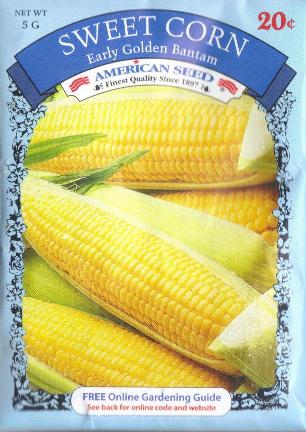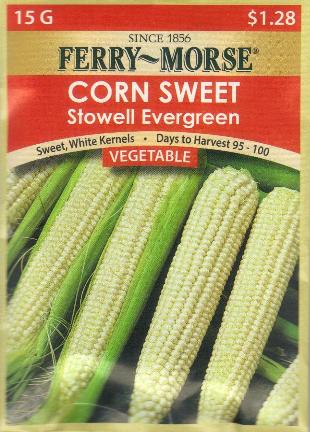
















Why Should You Buy a Few More Vegetable Seed Packages Each Spring?
Copyright © February 2, 2015 by Robert Wayne Atkins, P.E.
All Rights Reserved.
Introduction
Each spring it is a good idea to add some fresh vegetable seed packages to your inventory of emergency seed packages. A small investment in vegetable seed packages each year would allow you to gradually build a reasonable supply of vegetable seeds. If a hard times event forced you to grow your own food then those seed packages could make the difference between whether or not your family survived.
I personally do not have any complaints about the seeds that are available in my area that are packaged and sold by different seed companies. In fact, an experiment that I conducted in the year 2014 on vegetable seeds that were 11 years old (or older) revealed that approximately 33% (or more) of my old seeds were still alive and that they would germinate.
However, for any seed to germinate and grow into a healthy plant the following growing conditions must exist:
- Dirt Quality: The ground in which the seeds are planted must be acceptable to the seeds and it must contain the nutrients that the seeds need to grow. One way to enhance the nutrients in the soil is to add some type of fertilizer or compost to the soil.
- Ground Temperature: The soil temperature during the day must be warm enough to encourage the seed to germinate. The soil temperature at night cannot drop too low or it will inhibit germination. One way to help maintain a more consistent soil temperature during the day and during the night is to add a layer a mulch on top of the garden area.
- Planting Depth: One common mistake that new gardeners make is to plant all their vegetable seeds at the same approximate depth in the soil. This usually does not work because each type of seed needs to be planted at the correct depth for that type of seed. Read the back of the seed package and plant each type of vegetable seed at the depth recommended on the package.
- Row Length: Some vegetables are pollinated by insects and some are wind pollinated. To improve your harvest it is usually much better to plant several short rows of the same vegetable side-by-side the correct distance apart inside a square area instead of having one long straight row of vegetables.
- Hours of Sunlight: Most vegetables require full sun all day (or most of the day). Therefore do not select a shady spot as a garden area unless the specific type of vegetable that you are planting can survive in an area that does not get good sun.
- Water: Seeds will not germinate without enough moisture. If your garden doesn't receive enough rain after you plant your seeds then you will need to add water to your garden area.
Seed Cost

 The seed packages sold by different seed companies may contain the same exact type of vegetable seeds but the seed packages will be different due to:
The seed packages sold by different seed companies may contain the same exact type of vegetable seeds but the seed packages will be different due to:
1. Gram Weight = the number of seeds in the package.
2. Price = the cost of the seed package.
As an example, in January of the year 2015 Walmart had Early Golden Bantam seed available from two different seed companies as follows:
1. American Seed: 5 Grams for $0.20 ($0.20 / 5 = $0.040 per gram).
2. Ferry-Morse: 12 Grams for $1.28 ($1.28 / 12 = $0.107 per gram).
The Ferry-Morse package cost was 6.4 times more expensive than the American Seed package ($1.28 / $0.20).
The Ferry-Morse gram weight only contained 2.4 times more weight than the American Seed brand (12 / 5).
To satisfy my curiosity I selected a package of each company's seed at random and then I opened and counted the number of corn seeds in that package. The results were as follows:
1. American Seed = 30 corn seeds ($0.20 / 30 = $0.0067 per seed).
2. Ferry-Morse = 53 corn seeds ($1.28 / 53 = $0.0242 per seed).
The above results did not surprise me for two reasons:
1. Each individual corn seed may be of average size or it may be a little bigger or a little smaller than average.
2. The seed packages filled by machines will have some variability in the weight of the seeds in each package.
My conclusion based on the above data was that the American Seed brand seed packages were a better value than the Ferry-Morse brand seed packages.
However, there are fewer seed varieties available from American Seed when compared to the number of varieties available from Ferry-Morse. Therefore I purchased some seed packages from both seed companies the same way I do every spring. If a seed variety was available from American Seed then I purchased either one or two packages of that variety, depending on how important that type of vegetable was to me. But if a variety wasn't available from American Seed than I purchased one package of the Ferry-Morse variety.
Corn Seed
 I have always recommended the purchase of heirloom or open-pollinated seeds. And I have consistently recommended that you avoid hybrid seeds.
I have always recommended the purchase of heirloom or open-pollinated seeds. And I have consistently recommended that you avoid hybrid seeds.
Early Golden Bantam heirloom corn seed has always been available for sale in my area.
However, beginning in the year 2014 I noticed that some seed companies were selling a hybrid corn seed that contained "Early Golden Bantam" in the hybrid name of that seed. And in the year 2015 I again noticed this same hybrid Bantam corn seed.
In the year 2015 it is still possible to buy heirloom Early Golden Bantam corn seed but you need to be careful because a hybrid Early Golden Bantam corn seed is also available.
The year 2015 was the first year I was able to find a different variety of heirloom corn seed package available for sale in a standard size seed package. In the past if I wanted to buy any heirloom corn variety other than Early Golden Bantam corn then I had to make my purchase through an internet seed company, or from a seed catalog.
This year Walmart has Stowell Evergreen Sweet Corn seeds for sale in Ferry-Morse packages. The following information is printed on the back of the Ferry-Morse Stowell Evergreen Sweet Corn package: "Large 8-inch ears are filled with tender white kernels. Sweet flavor. An old-fashioned favorite. One of the best for canning and table. Remains in table condition longer than most."
I have been recommending Stowell's Evergreen White Corn on my website since the year 2010 as follows:
Stowell's Heirloom Evergreen White Corn: Before the corn is fully ripe pull up the stalks with the roots still attached and store them upside down inside your root cellar. The corn will continue to ripen over several months. Therefore you will be able to eat fresh corn-on-the-cob for between three to five more months. That is the reason it is called "evergreen corn." (Note: After the corn has fully ripened, if you will peel back the husks on one ear of corn on three or four different stalks and allow the corn to dry on the cob, then you will have fresh "corn seed" to plant in the spring. Twist the dry corn kernels off the cobs using your hands and discard the small tiny kernels near the end of the ear. Save the bigger corn kernels and plant them to produce another fresh crop of corn.)
Note: Stowell and Stowell's are the same variety of corn. Some seed companies simply omit the 's from the name of seed varieties and some seed companies do not.
Respectfully,
Grandpappy.
Grandpappy's e-mail address is: RobertWayneAtkins@hotmail.com





































 The seed packages sold by different seed companies may contain the same exact type of vegetable seeds but the seed packages will be different due to:
The seed packages sold by different seed companies may contain the same exact type of vegetable seeds but the seed packages will be different due to: I have always recommended the purchase of heirloom or open-pollinated seeds. And I have consistently recommended that you avoid hybrid seeds.
I have always recommended the purchase of heirloom or open-pollinated seeds. And I have consistently recommended that you avoid hybrid seeds.
